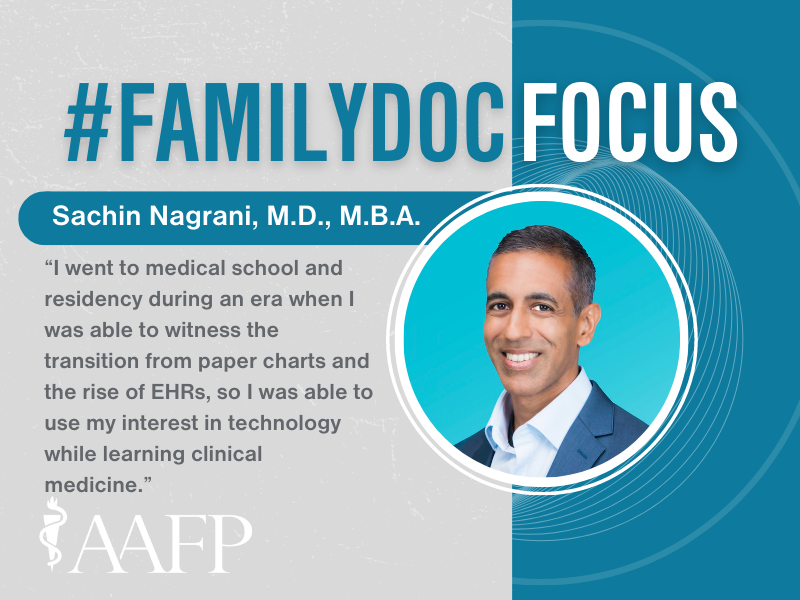FMX Speaker Merged Passion for Tech With Desire to Heal
August 3, 2022, 8:55 a.m. David Mitchell — Encouraged by his engineer father, Sachin Nagrani, M.D., M.B.A., grew up with computers and a passion for tech. As a physician, he’s integrated that hobby with his desire to help others.

“Trying to solve problems is why people go into medicine,” he said. “In the practice of medicine for an individual patient, you’re trying to solve somebody’s problem. The health care system itself is like an ill patient. There are many problems to solve for the system and the way we provide care, which equates to many opportunities to improve health.”
From 2013 to 2017, Nagrani was an urgent care physician for MedStar Health, which then had several urgent care centers in the Washington, D.C., area and now plans to build more. Some of its locations were much busier than others, causing frustration among physicians, staff and patients.
“The problem expanded with the number of clinics that were opening,” he said. “Physicians who were not busy were unhappy because they wanted to see more patients. Physicians who were too busy were unhappy because they wanted to see less. So we asked ourselves, ‘How do we shift the workload around?’”
Nagrani helped MedStar implement systems for online scheduling and virtual queuing that distributed workloads for clinical staff and shortened wait times for patients.
“It’s taken for granted now that these systems are widely available,” he said, “but several years ago, it was more difficult to know which urgent care center to visit.”
Nagrani also served as medical director for telehealth at MedStar. During his tenure, the health system, which has 10 hospitals and more than 250 outpatient facilities, implemented a telehealth system and transitioned to a new EHR system.
“I went to medical school and residency during an era when I was able to witness the transition from paper charts and the rise of EHRs,” he said, “so I was able to use my interest in technology while learning clinical medicine.”
Nagrani spent his first two years postresidency as an ER doctor, but he said his long-term goal is to work in whatever setting will allow him to help improve the practice of medicine for patients, doctors and all other health care workers. Since 2017, he has been national medical director of virtual health for Heal, which provides primary care for seniors in eight states through home visits, virtual care and remote monitoring.
“It’s very difficult to predict how technology is going to work in the future,” Nagrani said. “Many thought, at one point, that EHRs were going to be the technological solution to improve care. They solved some problems but not others, and subsequently new technologies have arisen to solve others. These new solutions often integrate with EHRs to maximize their effectiveness. Becoming an EHR power user is one way of demonstrating your interest in the space of technology, while also learning about the many other aspects of health care that intersect there.”
Telehealth became an area of strong interest for Nagrani, he said, “because it opens the door of possibility to practice medicine a different way — not for everything, but for many things — and create a better experience for patients and physicians.”
Prior to the pandemic, Nagrani said, about 10% of Americans had used a video-based telemedicine visit. After one year of COVID-19, that figure had increased to 75%.
“This year we see people returning to in-person services and activities,” he said, “but exposure has created a comfort level with using telemedicine. Every doctor that has used a telephone to interact with their patients has used telemedicine. We’ve been doing telemedicine for decades. What’s changing is the myriad ways in which it can be used and the potential for it to transform the way we practice medicine.”
During the 2022 Family Medicine Experience, which is scheduled for Sept. 20-23 in Washington, D.C., Nagrani will present a session on telehealth and remote patient monitoring that will cover different types of telehealth, how those different types of telehealth are reimbursed, and how to incorporate telehealth in practice in ways that are beneficial for patients and financially sustainable.
“I think many family physicians have felt like they’ve been working harder and have less say in the systems around them,” he said, “so I hope to encourage family physicians on how we can make changes in the way that we practice medicine, and how they can do it in their own practices, with examples of how to get started.”